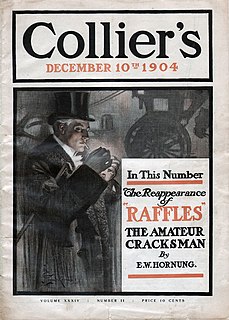
A. J. Raffles is a British fictional character – a cricketer and gentleman thief – created by E. W. Hornung. Between 1898 and 1909, Hornung wrote a series of 26 short stories, two plays, and a novel about Raffles and his fictional chronicler, Harry "Bunny" Manders.

Ernest William Hornung was an English author and poet known for writing the A. J. Raffles series of stories about a gentleman thief in late 19th-century London. Hornung was educated at Uppingham School; as a result of poor health he left the school in December 1883 to travel to Sydney, where he stayed for two years. He drew on his Australian experiences as a background when he began writing, initially short stories and later novels.
Dr. Richard Austin Freeman was a British writer of detective stories, mostly featuring the medico-legal forensic investigator Dr. Thorndyke. He invented the inverted detective story. Roberts said that this invention was Freeman's most noticeable contribution to detective fiction. Freeman used some of his early experiences as a colonial surgeon in his novels. Many of the Dr. Thorndyke stories involve genuine, but sometimes arcane, points of scientific knowledge, from areas such as tropical medicine, metallurgy and toxicology.
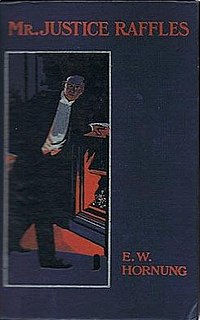
Mr. Justice Raffles is a 1909 novel written by E.W. Hornung. It featured his popular character A. J. Raffles a well-known cricketer and gentleman thief. It was the fourth and last in his four Raffles books which had begun with The Amateur Cracksman in 1899. The novel was published in the UK by Smith, Elder & Co., London, and in the US by Scribner's, New York.

Harry Manders is a fictional character in the popular series of Raffles stories by E. W. Hornung. He is the companion of A. J. Raffles, a cricketer and gentleman thief, who makes a living robbing the rich in late Victorian British High Society.

The Black Mask is a 1901 short story collection by E. W. Hornung. It was published in the UK by Grant Richards, London, and in the US by Scribner's, New York under the title Raffles: Further Adventures of the Amateur Cracksman. It is the second collection of stories in Hornung's series concerning A. J. Raffles, a gentleman thief in late Victorian London.

The Amateur Cracksman is an 1899 short story collection by E. W. Hornung. It was published in the UK by Methuen & Co., London, and in the US by Scribner's, New York. Many later editions expand the title to Raffles: The Amateur Cracksman. Some editions such as Penguin Books, 1948, retitle the collection simply, Raffles.

A Thief in the Night is a 1905 collection of short stories by E. W. Hornung. It was published in the UK by Chatto & Windus, London, and in the US by Scribner's, New York.

Raffles, the Amateur Cracksman (1925) is a feature length silent adventure crime drama/romance motion picture starring House Peters, Miss DuPont, Hedda Hopper, Fred Esmelton, and Walter Long.
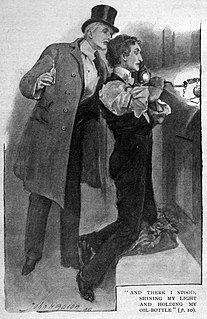
Arthur J. Raffles is a fictional character created in 1898 by E. W. Hornung, brother-in-law of Sir Arthur Conan Doyle, the creator of Sherlock Holmes. Raffles is, in many ways, an inversion of Holmes – he is a "gentleman thief", living at the Albany, a prestigious address in London, playing cricket as a gentleman for the Gentlemen of England and supporting himself by carrying out ingenious burglaries. He is called the "Amateur Cracksman" and often, at first, differentiates between him and the "professors" – professional criminals from the lower classes.

Stingaree is a 1905 novel by E. W. Hornung about an Australian bushranger. It was allegedly based on the Kelly Gang.
This article presents a list of the historical events and publications of Australian literature during 1890.
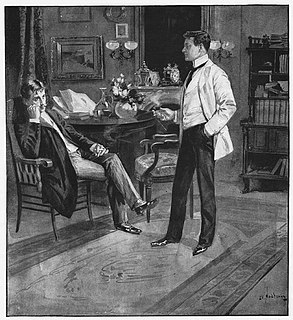
"The Ides of March" is a short story by E. W. Hornung, and the first appearance of the gentleman thief A. J. Raffles, and his companion and biographer, Bunny Manders. The story was first published in June 1898 by Cassell's Magazine. The story was also included in the collection The Amateur Cracksman, published by Methuen & Co. Ltd in London, and Charles Scribner's Sons in New York, both in 1899.
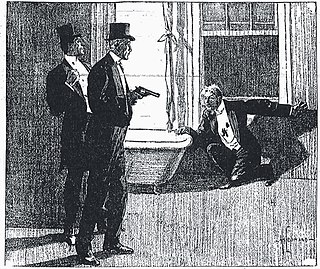
"Wilful Murder" is a short story by E. W. Hornung, and features the gentleman thief A. J. Raffles, and his companion and biographer, Bunny Manders. The story was first published as the fifth part of the collection The Amateur Cracksman, published by Methuen & Co. Ltd in London, and Charles Scribner's Sons in New York, both in 1899. This and "Le Premier Pas" were the two stories in the collection not published previously in magazine format.

"No Sinecure" is a short story by E. W. Hornung, and features the gentleman thief A. J. Raffles, and his companion and biographer, Bunny Manders. The story was first published in Scribner's Magazine in January 1901. The story was also included as the first story in the collection The Black Mask, published by Grant Richards in London, and Charles Scribner's Sons in New York, both in 1901.
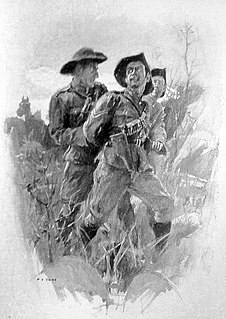
"The Knees of the Gods" is a short story by E. W. Hornung, and features the gentleman thief A. J. Raffles, and his companion and biographer, Bunny Manders. The story was first published as the eighth and final story in the collection The Black Mask, published by Grant Richards in London, and Charles Scribner's Sons in New York, both in 1901. It is the only story in the collection that was not first published separately in serial format.
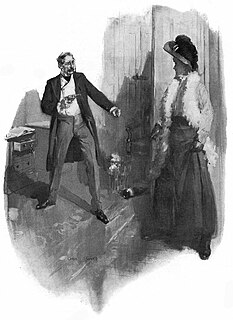
"The Rest Cure" is a short story by E. W. Hornung, and features the gentleman thief A. J. Raffles, and his companion and biographer, Bunny Manders. The story was published in February 1905 by Collier's Weekly in New York and in March 1905 by Pall Mall Magazine in London. The story was also included as the third story in the collection A Thief in the Night, published by Chatto & Windus in London, and Charles Scribner's Sons in New York, both in 1905.

"The Field of Philippi" is a short story by E. W. Hornung, and features the gentleman thief A. J. Raffles, and his companion and biographer, Bunny Manders. The story was published in April 1905 by Collier's Weekly in New York and in May 1905 by Pall Mall Magazine in London. The story was also included as the fifth story in the collection A Thief in the Night, published by Chatto & Windus in London, and Charles Scribner's Sons in New York, both in 1905.
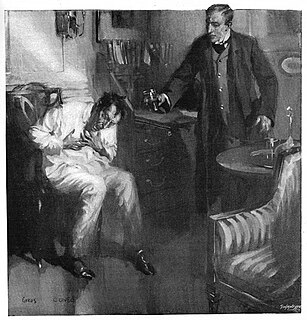
"A Bad Night" is a short story by E. W. Hornung, and features the gentleman thief A. J. Raffles, and his companion and biographer, Bunny Manders. The story was published in June 1905 by Pall Mall Magazine in London. The story was also included as the sixth story in the collection A Thief in the Night, published by Chatto & Windus in London, and Charles Scribner's Sons in New York, both in 1905.

















